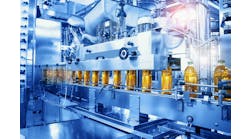It’s 1979. Your machine has suddenly stopped. You walk up to it with a million questions, but the most important one is: “What is wrong?”
Maybe you are lucky, and someone heard a clunk. Perhaps there is physical evidence; one of the widgets is jammed in a clamp station. You might even be fortunate enough to have a machine that has status lights that tell you when there is a motor overload or one of those high-tech machines where the designer has a graphic representation of the machine on a big board with little lights at key locations around the picture to show you where to look for the source of the trouble.
Or imagine that you have none of those features available, and you are faced with a machine that stopped running and no idea where to start looking for problems.
Many might be surprised to learn that, even now in 2019, there are still machines and processes out there that still don’t have a human-machine interface (HMI) to aid with the operation.
Many vintage machines are still around because they were built to last. In the absence of a means to graphically display the operating conditions of the machine, the owners of these workhorses would resort to hiring and training people with advanced skill sets to compensate for the lack of a window into the function of the machine. The investment in human resources was key to the success of a company.
As machines and processes became more sophisticated, a means to provide better information for the operator or technician became a very important addition to the design of a control system. Cathode ray tubes (CRTs) had been around for years, but the use of the technology didn’t reach the mainstream of control systems until the late 1980s when several manufacturers brought out devices that combined the display capabilities of a CRT with the input capabilities of a membrane keypad.
These early HMIs or operator interfaces (OIs) used the CRT to display the status of bits and integers in a PLC, and the membrane keypad was a means to provide input to the PLC, as well as a means to navigate to different screens that were displayed on the CRT.
Much has changed over the ensuing 30 years. The advent of the touchscreen eliminated the need for the membrane keypad. CRTs have given way to the liquid crystal display (LCD), small cells containing plasma that are then excited by electrical fields (plasma screens), then light emitting diode (LED) arrays and most recently organic light emitting diode (OLED) technology.
It is the progression of the display technology that has had the largest impact on the use of an operator interface in a control system. Screen resolutions are greatly improved, as is the viewing angle and the screen contrast. These improvements have prompted a change in the type of information that is exchanged between the PLC and the operator.
Early HMIs were really nothing more than a mimic board in an electronic format. Pushbuttons and selector switches, status indicators, numerical displays and inputs were common elements of these early devices. As the graphic ability of the technology improved, the ability to display elements that looked more like the physical devices greatly enhanced the appearance of the HMI.
The representation of objects on an HMI was originally limited to the use of a combination of squares (rectangles) and ellipses (circles) creatively placed such that some of the constructs of the object could be hidden by placing objects on top of objects.
Later versions could accept imported graphics from programs such as Paint, and, if properly formatted, these devices could be made to have dynamic properties that allowed for the image, or a portion of it, to change colors to represent the status of the actual devices. An example of this would be an image of a vessel that shows the level of the contents of that vessel.
One of the key features of those early HMIs was the realization that a savings on wiring could be realized by using the HMI instead of physical buttons on an operator panel. This added the ability to not only control the process via the HMI, but the HMI could be used to enable/disable functions at a level not reasonably possible with a panel of physical buttons and selector switches. The downside of doing this in a control system is the risk of your system’s being inoperable if the HMI fails.
Fast forward 30 years to 2019, and we see a significantly different human-machine interface. Screen resolutions in the area of 1280x1024 pixels bring crisp graphics and fast connections to the PLC, resulting in animations of functions that are practically seamless.
Package sizes are dramatically smaller, resulting in the ability to put a significantly larger screen in the same cutout as a much smaller version. The bezel on an operator screen used to be as much as 2 inches outside the size of the screen, mostly in order to support the weight of the screen itself.
Another major advance has been in the area of communications. Early operator interfaces were limited to RS-232 protocol communications with speeds as low as 300 baud (bits per second). Today’s HMI communicates at speeds of 100 million bits per second or greater. Faster speeds mean far better responses to the pressing of a button on the screen and the PLC receiving the input from the screen.
Two recent additions to the tool set of an HMI is the ability to run Active-X and PDF content from the user application. The former means that other applications can be called from within the operator-interface application. The latter has opened up the possibility of including hardware and software manuals on the operator interface and custom documents relative to the machine or process being controlled. The advantage here is that the operator or technician doesn’t need to retrieve the manual from an electrical enclosure or maintenance shop library. They can access the manual right on the operator interface itself. This significantly decreases the time needed to access appropriate information in the path to restoring a machine to operation.
Technology is only one of the advances in the human-machine interface. One trend that has, happily, gained traction is the unification of the PLC and HMI programming environment. Most major hardware suppliers have long had the ability to import the tag database from the PLC into the HMI software development application, but it formerly involved an intentional action to export the database from the PLC for use in the HMI or an action to point the HMI application at the PLC application in order to upload the tags into the HMI application. The focus on fully integrating the PLC and HMI development applications into a suite has resulted in a practically seamless unification of the two applications during development. In this type of cooperation between applications, a tag can now be created in the PLC database from within the HMI development software. Another new feature allows a tag to be identified as an alarm tag in the PLC and it is automatically included in the alarm list on the HMI.
Two other features of new HMIs are high-speed tags and add-on graphics. High-speed tags are assigned in the same manner as other HMI tags but are designated as high-speed tags. Think of this in the same way as an immediate input or output in the PLC. Buttons, so defined, are deterministic and auto-diagnosing, allowing for an HMI button to be used for jog functions that would normally involve lag that might make them less than desirable for that purpose.
Custom, reusable add-on graphics are a new feature that has great advantages for development of operator-interface applications. The developer can create custom graphic elements and then save them in a library for future use. This pre-built content can significantly reduce the time required to develop a new application.
The next two features are definitely the children of the smart-phone age. Newer HMIs have built-in virtual-network-computing (VNC) servers that allow access to the operator station via network with a smart phone or tablet. This tool is a boon to operator and maintenance mechanic alike, as a smart phone can be used as a remote-control device as one walks around the machine or process. In a further nod to the smart phone, some human-machine-interface units now have a navigation button, similar to the home button on a smart phone or tablet. Pressing this button brings up a navigation bar on the HMI that can be customized to suit the application. The great advantage of this feature is that more of the normal operator screen is available for content with the navigation button used to pop up a graphic with the customized navigation bar.
While today’s human-machine interface seems to be nothing like the HMI of yesterday, there are still some things to keep in mind when using this technology. The HMI is a tool, both for the user and the programmer. A tool is only useful if people are going to use it. Aside from the obvious control elements, a good HMI application also serves duty as the primary window into the inner workings of the machine or process. Build on the development of applications and employ continuous improvement on your design. Once the controls are in place, add troubleshooting by including a graphical display of the input and output modules of the PLC. Add screens to display the status and command structures of your VFD and servos. Think about adding popup help to your machine status page. Compare it to how easy it is to use your office copier now that a step-by-step prompt with pictures follows you through clearing a paper jam.
Finally, if your process or machine doesn’t require many changes, once set up, consider keeping the main controls as physical buttons to allow for operation in the event of an HMI failure. The same goes for a machine where starts and stops are common. No sense wearing out the touchscreen with constant use of the same spot on the screen.
The operator interface of today isn’t just a replacement for an operator’s console any more. Value-added features are coming out with each new product release, and it is very important to stay up on the vendor literature as many features make the design process quicker, and the result is an elaborate application that enhances the user experience.





